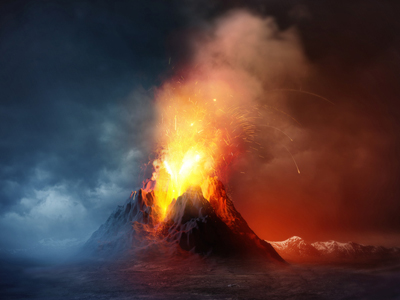
Tectonic Plates
A German meteorologist, Alfred Wegener, suggested that the continents may not have always been in the same place as we see them today. He believed that they had once all been joined together in a single landmass. He made his claim in the early part of the 20th century but scientists of the time dismissed his ideas as being silly.
Less than fifty years later, scientists realised that all of the evidence suggested that Wegener was correct and in the 1960s, evidence of seafloor spreading was the final piece of evidence that showed he was correct. This led to the development of the theory of plate tectonics and we now take these ideas for granted. For your GCSE, you are expected to know how this theory explains how the natural hazards of volcanoes and earthquakes occur as well as understanding how humans deal with them.
This quiz is only concerned with the physical geography of what has been termed the Restless Earth.
The Earth is made from distinct layers, one of which is the crust. This is the outer solid and cool layer of rocks. It is broken into large segments called plates. Some plates are comparable in size to the size of a small country whilst others are several times larger than any continent. Beneath the crust lies the mantle. The rocks here are extremely hot and slowly flow in giant convection currents. It is believed that these currents are the 'engine' that moves the plates around the surface of the Earth, carrying the continents with them.
Where plates meet, we say there is a plate boundary. There are three types of plate boundary (also called plate margins), constructive, destructive and conservative. Each type of plate boundary creates its own unique landforms - fold mountains, ocean trenches, shield and composite volcanoes, fissure volcanoes to name just a few.
At a constructive boundary, the plates move apart, magma pushes up between the plates, solidifies and so new material is added to the plates. There are non-explosive volcanoes and small earthquakes associated with this type of plate boundary. An example is the mid-Atlantic ridge.
Where plates slide past each other, no new material is added and no material is lost. This is why it is called a conservative boundary. There are no volcanoes of any type created by this type of plate movement but there are earthquakes, including some really big ones. The usual example of this sort of boundary is the San Andreas fault of North America.
When two plates meet head-on, you get a destructive boundary. One plate is pushed below the other and destroyed by melting in the mantle. The sediments lying on the plates are crumpled up to form mountain ranges. OK, the situation is much more complex than that but keeping that picture in your mind works at GCSE. At this type of boundary there are big earthquakes and explosive volcanoes. A good example of this is the Andes mountain range in South America.
Ready for more?
not all...
quizzers. Try to win a coveted spot on our Hall of Fame Page.







